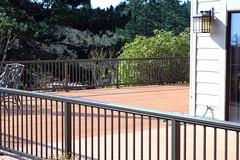Mixed Review on Elite Deck
 I recently installed a deck using a treated lumber product, Elite Deck. I have avoided treated decking in the past because of the tendency of the the fir lumber it is made from to split, cup, and check as it dries. This product comes in three colors and grey was chosen for this project. I was very concerned about this material because of my past experiences with similar products.
I recently installed a deck using a treated lumber product, Elite Deck. I have avoided treated decking in the past because of the tendency of the the fir lumber it is made from to split, cup, and check as it dries. This product comes in three colors and grey was chosen for this project. I was very concerned about this material because of my past experiences with similar products.
My general impression of the material is mixed, I liked the color, it is pleasing and goes good with the color of the home and was uniform. The overall quality of the lumber was below average in my opinion, I can pick a little better grade out of framing lumber at the yard, knot content and straightness was slightly below average for fir lumber. I would expect a decking material to be above average. The efficiency during install was a little low, the material had a tendency to split on the butt joints even when pre-drilled so you will want to budget a little extra lumber if you choose this product. This sounds overly negative I think but, considering the cost and the lack of needed maintenance down the road it may be worth it. The proof will be if it resists the splitting and cupping that this type of product has been prone to. This particular installation will get a deck cover and that played into the decision for the customer, the sun and UV radiation is the primary problem for this family of decking product.
I took several steps to safeguard this installation. First I tried whenever possible to use the factory butt joint as it has been treated with the chemical solution already. When it was necessary to use a site cut edge I treated it with a end-cut solution as in the installation instructions and followed that with an application of Anchor-Seal. Anchor-Seal is a product that is often used during the installation of hardwoods. It is a liquid paraffin that absorbs into the end grain of lumber. The rapid gain and loss of of moisture through the end grain of lumber is what is responsible for cracking and checking at the end of boards, stopping this by sealing it is an effective way to prevent this type of damage. Lastly, immediately after install I applied a coat of Wolman clear deck sealer to trap the moisture inside the boards to slow the drying. Rapid drying can also lead to surface checking and cracking. This is the opposite technique than that of un-treated decking which you would want to dry completely before you applied a sealer.
If you do not want any maintenance on your deck and are on a budget, treated decking may be a good choice for you, you just should not expect a perfectly defect free surface. Treated decking is excellent in longevity just not high in appearance.










